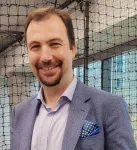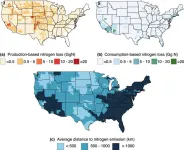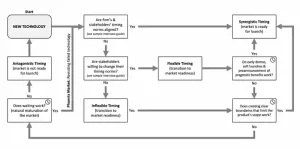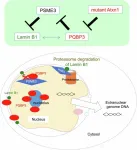(Press-News.org) A patient dozes off in a dental chair despite the anxiety of an impending procedure. A seemingly unremarkable act but — for dentists versed in the latest sleep research — this red flag hints at a life-threatening condition.
In a research review published in the Journal of the American Dental Association, Rutgers Health researchers identified dentists as an unexpected player in the battle against life-threatening sleep disorders.
The review suggests dental professionals have unique opportunities to screen for conditions such as obstructive sleep apnea, a disorder that affects millions of Americans and is linked to serious health risks, including cardiovascular disease and neurodegeneration.
It also challenges dentists to look beyond teeth and gums to the broader landscape of patient health.
"We have a great opportunity to change lives for the better," said Davis Thomas, a clinical associate professor at the Rutgers School of Dental Medicine and senior author of the review. "Dentists can be the first line of defense in identifying sleep disorders. They often see symptoms long before physicians. Indicators like tooth grinding, tongue scalloping or even a patient dozing off in the chair can be early signs that something more is going on."
Sleep disorders such as obstructive sleep apnea affect more than half of Americans at some point in their lives. Many cases go undiagnosed, but dentists can play an important role in reducing those numbers.
The review outlines several key indicators that dental clinicians should look for during examinations, including enlarged jaw muscles, scalloped tongue edges, white lines on the cheeks, restricted visibility of the throat, dental wear patterns and tiny cracks on teeth.
These physical signs, combined with patient history and simple screening tools, can help dentists identify at-risk patients with up to 80 percent accuracy.
"It's not just about looking at teeth anymore," Thomas said. "We need to observe the whole patient, from their behavior in the waiting room to the subtle signs in their oral cavity."
Another sign of concern, according to the review authors, is bruxism, commonly known as teeth grinding. Contrary to long-held beliefs, the studies suggest teeth griding is often a symptom of underlying sleep issues rather than a standalone problem caused by dental misalignment.
"We've been treating the symptoms without addressing the root cause for far too long," Thomas said. "By understanding the neuroscience behind sleep disorders, we can provide more comprehensive care and potentially prevent serious health complications."
This shift in perspective could have far-reaching implications. By identifying patients at risk for sleep disorders, dentists can facilitate early intervention, potentially preventing complications such as hypertension, heart disease and stroke.
To implement these findings, Thomas and his team propose a simple protocol for dental practices: Incorporate sleep-related questions into patient history forms. Other recommendations include training dental staff to recognize physical signs of sleep disorders and using validated screening tools like the STOP-BANG (snoring, tiredness, observed apnea, blood pressure, body mass index, age, neck size, gender) questionnaire, which screens for obstructive sleep apnea and establish referral networks with sleep medicine specialists.
"We're not asking dentists to diagnose sleep disorders," Thomas said. "We're asking them to recognize the signs and make appropriate referrals. This simple act can be lifesaving."
Thomas recommends that dentists looking to incorporate sleep screening into their practices start with education.
"Attend sleep medicine conferences, take continuing education courses, and stay up-to-date with the latest research," he said. "The more we learn, the more we realize how much we don't know – and how much we can do to help our patients."
END
From cavities to sleep apnea: dentists can assume new role in saving lives
2024-09-03
ELSE PRESS RELEASES FROM THIS DATE:
Department of Energy awards $125 Million for research to enable next-generation batteries and energy storage
2024-09-03
WASHINGTON, D.C. - Today, the U.S. Department of Energy (DOE) announced $125 million in funding for two Energy Innovation Hub teams to provide the scientific foundation needed to seed and accelerate next generation technologies beyond today’s generation of lithium (Li)-ion batteries. These multi-institution research teams, led by Argonne National Laboratory and Stanford University, will develop scientific concepts and understanding to impact decarbonization of transportation and incorporation of clean energy into the electricity grid.
Rechargeable batteries, such as Li-ion and lead-acid batteries, have had a ...
New provincial funding to help drive connected and autonomous vehicle research at uOttawa
2024-09-03
The University of Ottawa has been awarded a $1 million grant from the Ontario Research Fund – Research Excellence (ORF-RE) to support the “Secure, Intelligent and Trustworthy Ecosystems for Connected and Autonomous Vehicles” (SITE-CAV) project.
Led by Burak Kantarci,Full Professor, School of Electrical Engineering and Computer Science, uOttawa’s Faculty of Engineering, the project aims to accelerate the development and integration of connected and autonomous vehicles (CAVs – or vehicles equipped with sensors and decision-making software that drives and controls it without direct ...
Department of Energy selects Argonne to lead national energy storage hub
2024-09-03
Today the U.S. Department of Energy (DOE) announced the creation of two new Energy Innovation Hubs. One of the national hubs, the Energy Storage Research Alliance (ESRA), is led by DOE’s Argonne National Laboratory and co-led by DOE’s Lawrence Berkeley National Laboratory (Berkeley Lab) and Pacific Northwest National Laboratory (PNNL).
ESRA (pronounced ez-ruh) brings together nearly 50 world-class researchers from three national laboratories and 12 universities to provide the scientific ...
People eating beef are less likely to live near the industry’s pollution, Pitt researchers found
2024-09-03
Anyone who’s researched ways to lower their environmental impact has likely heard they should eat less meat, particularly beef. Even at scale, cows are an inefficient way to feed people — it takes nearly four tons of water to recoup one ton of beef, and many farming practices emit greenhouse gasses and pollutants.
University of Pittsburgh researchers are the first to trace one of those pollutants, nitrogen, along the U.S. beef supply chain at the county level. They found high spatial disconnect between where ...
Can technology turn exercise pain into pleasure?
2024-09-03
Virtual reality (VR) video games that combine screen time with exercise are a great way to get fit, but game designers face a major challenge – like with regular exercise, adherence to ‘exergames’ is low, with most users dropping out once they start to feel uncomfortable or bored.
Computer scientists at the University of Bath believe they’ve found a solution: create exergames that use sensors to continuously measure a person’s emotional state while they exercise, then tweak the game – for instance, making ...
When is the right time to launch new technologies?
2024-09-03
New research from Bayes Business School (formerly Cass) finds that being on the cutting edge of technology is not enough to ensure success in the market, and managers must strategically time launches to create a source of opportunity and credibility for the firm.
The study, led by Dr Thomas Robinson, Senior Lecturer in Marketing at Bayes, with Dr Ela Veresiu, Associate Professor of Marketing at Schulich School of Business, York University, Toronto, develops a framework for guiding organisations on the best situations for a product launch.
The research identifies four timing situations that can confront marketing managers. Knowing ...
Mayo researchers develop tool that measures health of a person’s gut microbiome
2024-09-03
ROCHESTER, Minn. — A team of Mayo Clinic researchers has developed an innovative computational tool that analyzes the gut microbiome, a complex ecosystem of trillions of bacteria, fungi, viruses and other microorganisms within the digestive system, to provide insights into overall well-being.
In a new study published in Nature Communications, the tool demonstrated at least 80% accuracy in differentiating healthy individuals from those with any disease. The tool was developed by analyzing ...
Unveiling the molecular mechanisms linking aging with neurodegenerative diseases
2024-09-03
Tokyo Medical and Dental University (TMDU) researchers elucidate the role of PQBP3 in stabilizing the nuclear membrane and its relationship to senescence and neurodegeneration
Tokyo, Japan – Aging is the prime cause of neurodegenerative diseases, such as Alzheimer’s disease, Parkinson's disease, and amyotrophic lateral sclerosis. But what exactly increases the prevalence of these brain disorders as one grows older? The molecular forces linking aging, cellular senescence, and the onset of these neurodegenerative conditions ...
Keep devices out of bed for better sleep – Otago study
2024-09-03
Despite what we’ve been led to believe, the timing of evening screen use, rather than the activity itself, negatively impacts youth sleep, a University of Otago study has found.
Current sleep guidelines recommend no screen use in the hour or two before bed. However, the researchers found screen time in the two hours before bed had little impact on youth sleep, it was screen time once in bed that caused problems.
Lead author Dr Bradley Brosnan, of the Edgar Diabetes and Obesity Research Centre, says screen time is a mainstay in adolescents’ bedtime routines, and sleep guidelines need to be revaluated to better reflect modern life.
Published in JAMA Pediatrics, ...
Dr. Torabi to study vulnerabilities in electric vehicle charging management systems
2024-09-03
Dr. Sadegh Torabi, Assistant Professor, Information Sciences and Technology, College of Engineering and Computing (CEC), and Research Fellow at the Center for Secure Information Systems (CSIS), is set to receive funding for the project: “Collaborative Research: CISE MSI: RPEP: OAC: Macroscopic and Microscopic Inference and Analysis of Vulnerabilities within EV Charging-Management Systems.”
Via this project, Dr. Torabi and his partners will establish a collaborative ecosystem among academia, industry, and the public sector to bolster the resilience of the EV Charging Infrastructure (CI). The critical nature of EV CI has made them targets for malicious attacks, often state-sponsored, ...



